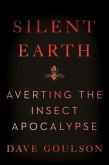- Broschiertes Buch
- Merkliste
- Auf die Merkliste
- Bewerten Bewerten
- Teilen
- Produkt teilen
- Produkterinnerung
- Produkterinnerung
"An overview of what biologists have learned about the mechanisms underlying a wide variety of avian behaviors, ranging from feeding, sex, and migration to complex cognition and sociality"--
Andere Kunden interessierten sich auch für
![Biological Rhythms Biological Rhythms]() Daniel B. ForgerBiological Rhythms10,99 €
Daniel B. ForgerBiological Rhythms10,99 €![The Longevity Book The Longevity Book]() Cameron DiazThe Longevity Book23,99 €
Cameron DiazThe Longevity Book23,99 €![Human Human]() Michael S. GazzanigaHuman16,99 €
Michael S. GazzanigaHuman16,99 €![Feminism in the Wild Feminism in the Wild]() Ambika KamathFeminism in the Wild15,99 €
Ambika KamathFeminism in the Wild15,99 €![Silent Earth Silent Earth]() Dave GoulsonSilent Earth37,99 €
Dave GoulsonSilent Earth37,99 €![Endless Forms Endless Forms]() Seirian SumnerEndless Forms26,99 €
Seirian SumnerEndless Forms26,99 €![The Book of Eels The Book of Eels]() Patrik SvenssonThe Book of Eels27,99 €
Patrik SvenssonThe Book of Eels27,99 €-
-
"An overview of what biologists have learned about the mechanisms underlying a wide variety of avian behaviors, ranging from feeding, sex, and migration to complex cognition and sociality"--
Produktdetails
- Produktdetails
- Verlag: MIT Press Ltd
- Seitenzahl: 296
- Erscheinungstermin: 5. August 2025
- Englisch
- Abmessung: 252mm x 177mm x 21mm
- Gewicht: 626g
- ISBN-13: 9780262552738
- ISBN-10: 0262552736
- Artikelnr.: 73776423
- Herstellerkennzeichnung
- Libri GmbH
- Europaallee 1
- 36244 Bad Hersfeld
- gpsr@libri.de
- Verlag: MIT Press Ltd
- Seitenzahl: 296
- Erscheinungstermin: 5. August 2025
- Englisch
- Abmessung: 252mm x 177mm x 21mm
- Gewicht: 626g
- ISBN-13: 9780262552738
- ISBN-10: 0262552736
- Artikelnr.: 73776423
- Herstellerkennzeichnung
- Libri GmbH
- Europaallee 1
- 36244 Bad Hersfeld
- gpsr@libri.de
Georg F. Striedter is Professor of Neurobiology and Behavior at the University of California, Irvine. His books include Principles of Brain Evolution, Brains Through Time: A Natural History of Vertebrates, and Model Systems in Biology (MIT Press). Andrew N. Iwaniuk is Professor at the University of Lethbridge. He has published more than 100 research articles, most of which are on bird brains and behavior.
Preface
Chapter 1: And Introduction to Birds and their Brains
1.1 Birds in the Vertebrate Family Tree
1.2 Phylogeny of Modern Birds
1.3—Avian Brain Size and Neuron Density
1.4—Avian Brain Organization
1.5—Conclusion: Different, yet not so Different
Chapter 2: Daily and Seasonal Rhythms
2.1—Circadian Rhythms
2.2—Sleep in Birds
2.3—Seasonal Changes in Brains and Behavior
Chapter 3: Locomotion and Posture Control
3.1—Flight
3.2—Walking and Running
3.3—Standing Still
Chapter 4: Homing and Migration
4.1—Spatial Orientation and Navigation: Key Concepts
4.2—The Compass Senses of Birds
4.3—Navigational Maps
4.4—Brain Pathways for Orientation and Navigation
4.5—Many Unanswered Questions
Chapter 5: Feeding and Storing Food
5.1—Ground-feeding Birds
5.2—Hunting on the Wing
5.3—Owls Hunting at Night
5.4—Searching for Hidden Food
5.5—Food Storing and Retrieval
5.6—Appetite Regulation
Chapter 6: Sex and Social Behavior
6.1 Sex Determination and Sexual Differentiation
6.2—Sex Differences in the Brain
6.3—Neural Control of Song
6.4—Vocal Control in Non-songbirds
6.5—Non-vocal Displays
6.6—Species, Sex, and Kin Recognition
6.7—Nesting and Parental Care
6.8—To Flock or not to Flock
Chapter 7: Complex Cognition
7.1—The Surprising Complexity of Avian Brains and Cognition
7.2—Memories of What, Where, When
7.3—Feeding Innovations and Tool Use
7.4—Social Intelligence
7.5—An Avian “Prefrontal Cortex”?
7.6—Homology versus Analogy
Chapter 8: The Complex Relationship Between Birds and Us
8.1—Hunting
8.2—Domestication
8.3—Anthropogenic Effects
8.4—Is there a Bright Side?
Appendix: Homologies of the Avian Pallium
A.1–Pallium versus Subpallium
A.2—Hippocampus
A.3—Hyperpallium
A.4—Mesopallium
A.5—Nido- and Arcopallium
A.6—Olfactory Cortex
A.7—Functional Implications
Related Videos and Further Reading
Appendix
Chapter 1: And Introduction to Birds and their Brains
1.1 Birds in the Vertebrate Family Tree
1.2 Phylogeny of Modern Birds
1.3—Avian Brain Size and Neuron Density
1.4—Avian Brain Organization
1.5—Conclusion: Different, yet not so Different
Chapter 2: Daily and Seasonal Rhythms
2.1—Circadian Rhythms
2.2—Sleep in Birds
2.3—Seasonal Changes in Brains and Behavior
Chapter 3: Locomotion and Posture Control
3.1—Flight
3.2—Walking and Running
3.3—Standing Still
Chapter 4: Homing and Migration
4.1—Spatial Orientation and Navigation: Key Concepts
4.2—The Compass Senses of Birds
4.3—Navigational Maps
4.4—Brain Pathways for Orientation and Navigation
4.5—Many Unanswered Questions
Chapter 5: Feeding and Storing Food
5.1—Ground-feeding Birds
5.2—Hunting on the Wing
5.3—Owls Hunting at Night
5.4—Searching for Hidden Food
5.5—Food Storing and Retrieval
5.6—Appetite Regulation
Chapter 6: Sex and Social Behavior
6.1 Sex Determination and Sexual Differentiation
6.2—Sex Differences in the Brain
6.3—Neural Control of Song
6.4—Vocal Control in Non-songbirds
6.5—Non-vocal Displays
6.6—Species, Sex, and Kin Recognition
6.7—Nesting and Parental Care
6.8—To Flock or not to Flock
Chapter 7: Complex Cognition
7.1—The Surprising Complexity of Avian Brains and Cognition
7.2—Memories of What, Where, When
7.3—Feeding Innovations and Tool Use
7.4—Social Intelligence
7.5—An Avian “Prefrontal Cortex”?
7.6—Homology versus Analogy
Chapter 8: The Complex Relationship Between Birds and Us
8.1—Hunting
8.2—Domestication
8.3—Anthropogenic Effects
8.4—Is there a Bright Side?
Appendix: Homologies of the Avian Pallium
A.1–Pallium versus Subpallium
A.2—Hippocampus
A.3—Hyperpallium
A.4—Mesopallium
A.5—Nido- and Arcopallium
A.6—Olfactory Cortex
A.7—Functional Implications
Related Videos and Further Reading
Appendix
Preface
Chapter 1: And Introduction to Birds and their Brains
1.1 Birds in the Vertebrate Family Tree
1.2 Phylogeny of Modern Birds
1.3—Avian Brain Size and Neuron Density
1.4—Avian Brain Organization
1.5—Conclusion: Different, yet not so Different
Chapter 2: Daily and Seasonal Rhythms
2.1—Circadian Rhythms
2.2—Sleep in Birds
2.3—Seasonal Changes in Brains and Behavior
Chapter 3: Locomotion and Posture Control
3.1—Flight
3.2—Walking and Running
3.3—Standing Still
Chapter 4: Homing and Migration
4.1—Spatial Orientation and Navigation: Key Concepts
4.2—The Compass Senses of Birds
4.3—Navigational Maps
4.4—Brain Pathways for Orientation and Navigation
4.5—Many Unanswered Questions
Chapter 5: Feeding and Storing Food
5.1—Ground-feeding Birds
5.2—Hunting on the Wing
5.3—Owls Hunting at Night
5.4—Searching for Hidden Food
5.5—Food Storing and Retrieval
5.6—Appetite Regulation
Chapter 6: Sex and Social Behavior
6.1 Sex Determination and Sexual Differentiation
6.2—Sex Differences in the Brain
6.3—Neural Control of Song
6.4—Vocal Control in Non-songbirds
6.5—Non-vocal Displays
6.6—Species, Sex, and Kin Recognition
6.7—Nesting and Parental Care
6.8—To Flock or not to Flock
Chapter 7: Complex Cognition
7.1—The Surprising Complexity of Avian Brains and Cognition
7.2—Memories of What, Where, When
7.3—Feeding Innovations and Tool Use
7.4—Social Intelligence
7.5—An Avian “Prefrontal Cortex”?
7.6—Homology versus Analogy
Chapter 8: The Complex Relationship Between Birds and Us
8.1—Hunting
8.2—Domestication
8.3—Anthropogenic Effects
8.4—Is there a Bright Side?
Appendix: Homologies of the Avian Pallium
A.1–Pallium versus Subpallium
A.2—Hippocampus
A.3—Hyperpallium
A.4—Mesopallium
A.5—Nido- and Arcopallium
A.6—Olfactory Cortex
A.7—Functional Implications
Related Videos and Further Reading
Appendix
Chapter 1: And Introduction to Birds and their Brains
1.1 Birds in the Vertebrate Family Tree
1.2 Phylogeny of Modern Birds
1.3—Avian Brain Size and Neuron Density
1.4—Avian Brain Organization
1.5—Conclusion: Different, yet not so Different
Chapter 2: Daily and Seasonal Rhythms
2.1—Circadian Rhythms
2.2—Sleep in Birds
2.3—Seasonal Changes in Brains and Behavior
Chapter 3: Locomotion and Posture Control
3.1—Flight
3.2—Walking and Running
3.3—Standing Still
Chapter 4: Homing and Migration
4.1—Spatial Orientation and Navigation: Key Concepts
4.2—The Compass Senses of Birds
4.3—Navigational Maps
4.4—Brain Pathways for Orientation and Navigation
4.5—Many Unanswered Questions
Chapter 5: Feeding and Storing Food
5.1—Ground-feeding Birds
5.2—Hunting on the Wing
5.3—Owls Hunting at Night
5.4—Searching for Hidden Food
5.5—Food Storing and Retrieval
5.6—Appetite Regulation
Chapter 6: Sex and Social Behavior
6.1 Sex Determination and Sexual Differentiation
6.2—Sex Differences in the Brain
6.3—Neural Control of Song
6.4—Vocal Control in Non-songbirds
6.5—Non-vocal Displays
6.6—Species, Sex, and Kin Recognition
6.7—Nesting and Parental Care
6.8—To Flock or not to Flock
Chapter 7: Complex Cognition
7.1—The Surprising Complexity of Avian Brains and Cognition
7.2—Memories of What, Where, When
7.3—Feeding Innovations and Tool Use
7.4—Social Intelligence
7.5—An Avian “Prefrontal Cortex”?
7.6—Homology versus Analogy
Chapter 8: The Complex Relationship Between Birds and Us
8.1—Hunting
8.2—Domestication
8.3—Anthropogenic Effects
8.4—Is there a Bright Side?
Appendix: Homologies of the Avian Pallium
A.1–Pallium versus Subpallium
A.2—Hippocampus
A.3—Hyperpallium
A.4—Mesopallium
A.5—Nido- and Arcopallium
A.6—Olfactory Cortex
A.7—Functional Implications
Related Videos and Further Reading
Appendix








